Foyers vary in size, functionality, uses, and furniture choices, influencing renovation decisions. Typical residential foyers measure between 45 square feet (4 square meters) and 65 square feet (6 square meters), providing enough space for entering and removing outerwear. Foyers serve as transitional spaces for entering a home, offering storage and furniture for storing belongings. They function as entrances, providing space for removing outerwear and storing items. Standard foyer furnishings include console tables for display and storage, hall trees with hooks and benches, benches or settees for seating, mirrors for light reflection and appearance checks, artwork for aesthetic enhancement, storage furniture for organization, and lighting fixtures to set the atmosphere. Foyer colors include white for a clean look, gray for sophistication, blue for a calming effect, beige for warmth, green for a natural touch, yellow for brightness, and red for bold statements. Energy efficiency in foyers is achieved through efficient lighting, maximizing natural light, proper insulation, and using energy-efficient appliances and fixtures. This includes using LED or CFL bulbs, positioning windows or skylights strategically, ensuring adequate insulation, and selecting energy-efficient doors and thermostats. Factors affecting foyer renovation include wall condition, lighting, space availability, current trends, desired aesthetics, functionality, and budget. An architect may not always be required for a foyer renovation but can be valuable for significant changes. Architects help in space optimization, structural changes, lighting design, material selection, aesthetic guidance, creating a “wow factor,” and budget management. Redecorating a foyer takes 2 to 6 weeks, influenced by the project’s scope, material availability, design complexity, and workforce efficiency. Homeowners need help decorating a foyer, including managing clutter, limited space, wall conditions, lighting challenges, style selection, and budget constraints.
What is the typical size of a foyer?
The typical size of a foyer ranges from 45 square feet (4 square meters) to 65 square feet (6 square meters) in floor space. This allows enough area for entering the home and removing outerwear before flowing into adjacent rooms. A standard 6.5 feet (2 meters) tall, 3 feet (0.9 meters) x 6.5 feet (2 meters) front door opens into the space. Console tables or a slim shelf unit are 1 foot (0.3 meters) to 2 feet (0.6 meters) deep along one wall. The ceiling height spans 8 feet (2.4 meters) to 9 feet (2.7 meters). Average home foyers measure 55 square feet (5 square meters) to 85 square feet (8 square meters). An average 3 feet (0.9 meters) x 7 feet (2.1 meters) entrance door leads into the area. There is room for a narrow entryway bench or shelf 1-2 feet (0.3-0.6 meters) deep on one wall or a centered 1.5-foot (0.45 meters) console table. Ceiling heights remain average at 8-9 feet (2.4-2.7 meters). The footprint lets multiple people comfortably remove coats or shoes before transitioning inside. Grand foyers in luxury homes span 215+ square feet (20+ square meters) minimally, often 430+ square feet (40+ square meters). Soaring 9+ feet (2.7+ meters) ceilings reach double height 20+ feet (6+ meters) openings for an impression. High-end foyers fit substantial 2.5-3 foot (0.7-1 meter) deep benches, 2-3 foot (0.6-0.9 meter) consoles, artwork, sconces, and moldings or treatments, befitting the palatial.
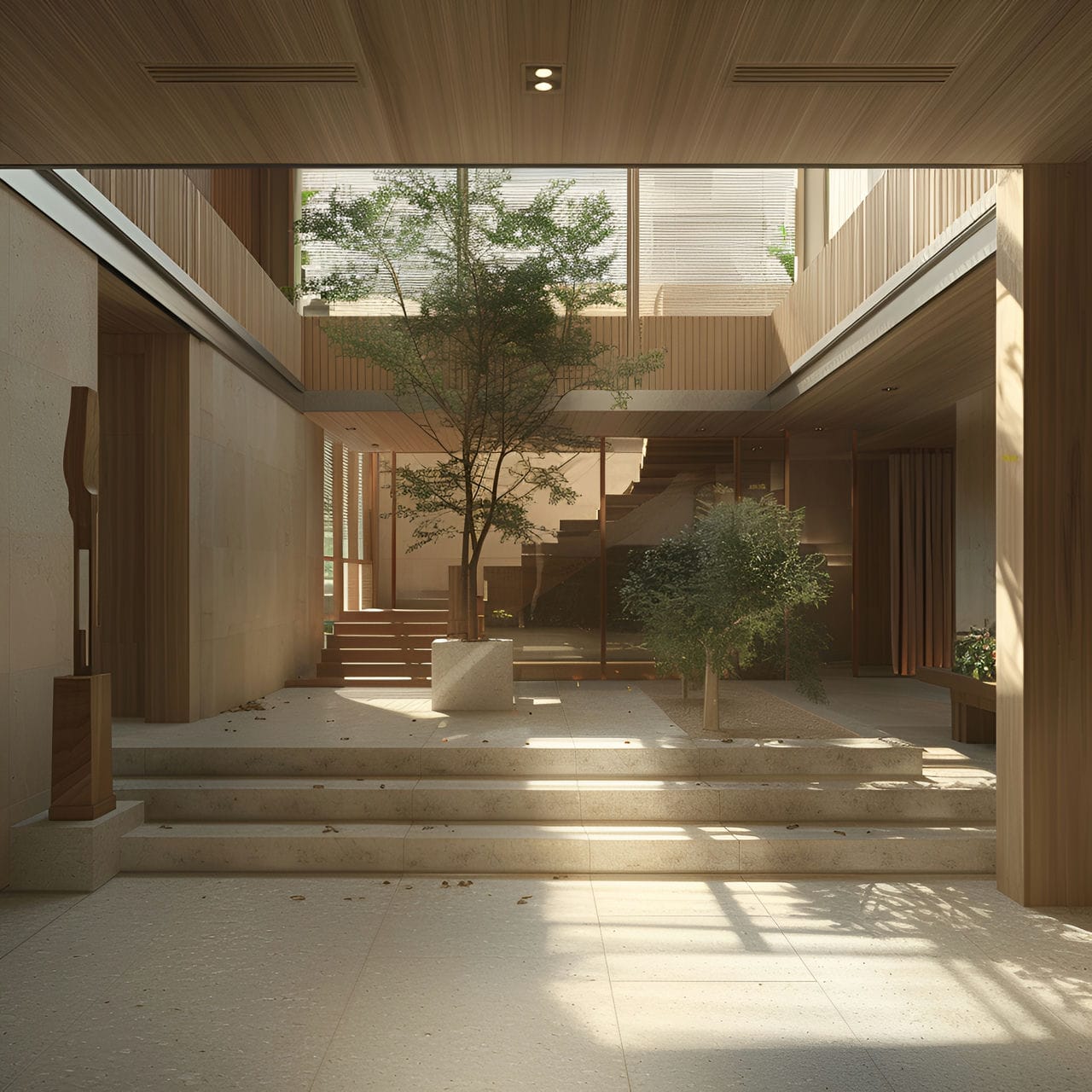
What is the use and purpose of foyers?
The purpose of a foyer is to provide transitional space for arriving home, storage, and furniture for temporarily setting down belongings. Firstly, a foyer is an entrance or lobby leading into a home or building. Its primary purpose is to serve as a transitional space when entering the house, allowing residents and guests to pause upon arrival before moving deeper into the interior rooms. Secondly, the foyer has several practical uses as an entrance. It provides a convenient spot for removing outerwear like coats, hats, gloves, etc. Foyers contain a closet or coat hooks for hanging up items. The space may also include a bench, small table, or shelves for storing bags, keys, mail, etc. Lastly, the foyer sets the decorative tone for the rest of the home. The style of furnishings, flooring, lighting fixtures, wall colors, and accent pieces introduce visitors to the aesthetic. Grand foyers with sweeping staircases make first impressions, while cozy galley-style spaces feel more intimate.
What is the typical shape of a foyer?
The typical shape of a residential foyer is a rectangle or a square. A rectangular foyer ranges from 3 feet (0.9 meters) to 4 feet (1.2 meters) wide to allow space for the front door to open comfortably with a 1.5-foot (0.5 meter) to 3-foot (1 meter) clearance on either side. It extends 5 feet (1.5 meters) to 10 feet (3 meters) deep from the entrance. This layout easily fits into entry spaces and efficiently flows into adjoining rooms or hallways. An average square foyer spans 5 feet (1.5 meters) to 10 feet (3 meters) on each side, maximizing usable floor space. Average foyers are often squares or rectangles, with dimensions ranging from 3 feet (0.9 meters) to 10 feet (3 meters) per side. Large luxury foyers may incorporate curved walls or unique shapes, and standard rectangular or square layouts ranging from 5 feet (1.5 meters) to 20+ feet (6+ meters) per side remain the most common and functional for typical entry spaces.
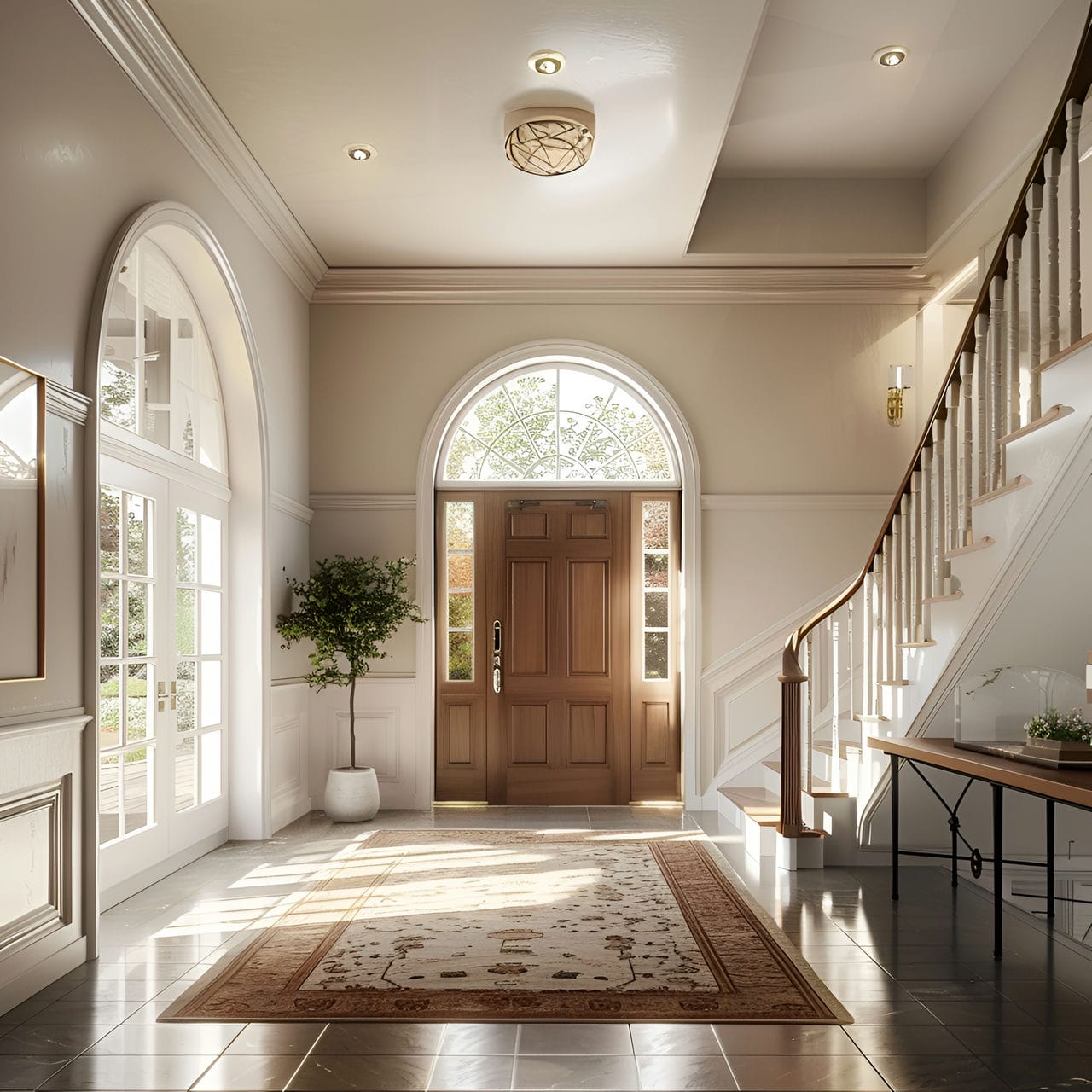
What furniture commonly equips a foyer?
Listed below are the types of furniture commonly equip a foyer:
- Console Table: A console table is a versatile piece of furniture to display decorative items, store keys, or hold mail in a foyer. This piece can be styled in various ways to reflect the home’s aesthetic, from rustic to modern, and can serve as a foundation for seasonal decor.
- Hall Tree: A hall tree is a piece of functional furniture in a foyer that includes hooks for hanging coats, a bench for seating, and sometimes storage underneath. It adds purpose and provides a designated place for guests to hang their coats and bags upon arrival.
- Bench or Settee: A bench or settee in the foyer provides a place for people to sit while removing shoes or waiting for others. It can be tucked beneath a console table or placed against a wall. This piece of furniture can also be used to add a pop of color or texture to the space.
- Mirror: Mirrors are a common furniture in foyers. They provide a last-minute check before leaving the house and reflect light, making the space feel larger and brighter—vintage mirrors with ornate frames.
- Artwork: Artwork can make a bold statement in a foyer, showcasing the homeowner’s taste at the entrance. This furniture can range from a single, large piece for maximum impact to a collection of smaller pieces arranged in a gallery wall style.
- Storage Furniture: Storage furniture like sideboards, dressers, or small bookcases can be helpful in a foyer. They provide additional storage for items like shoes, umbrellas, or hats, keeping the entryway tidy and organized.
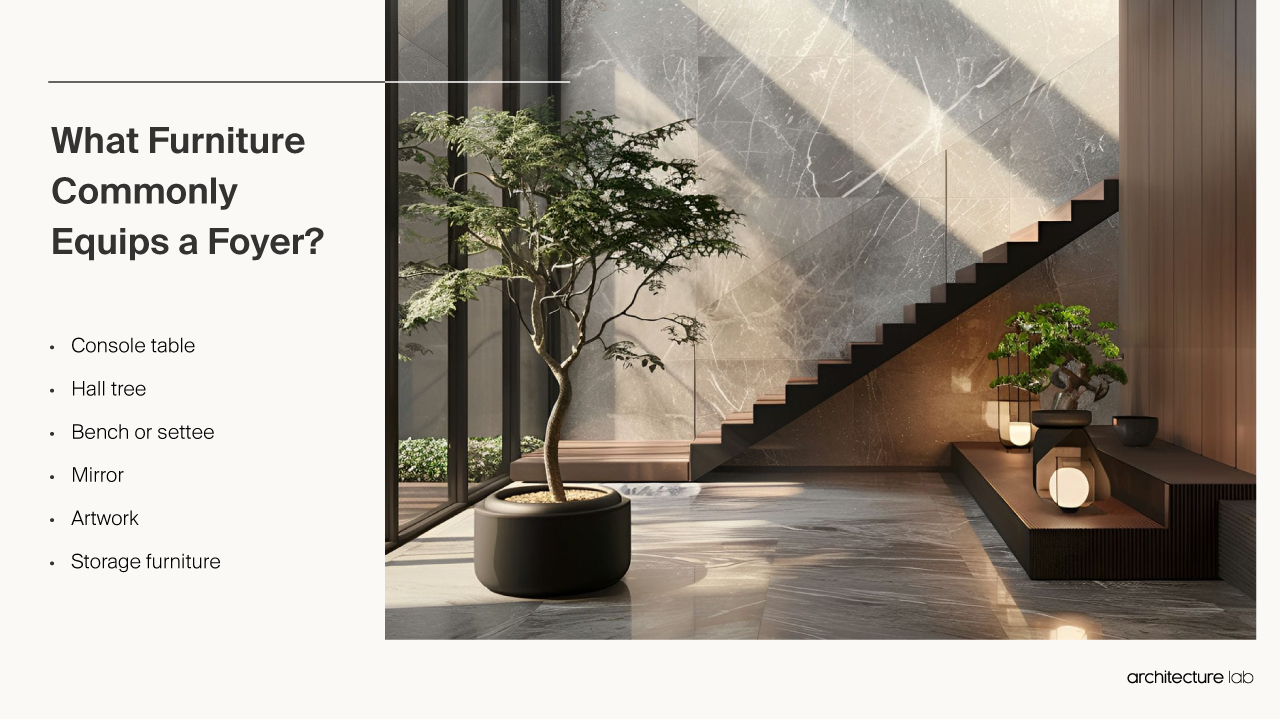
What is the normal ceiling height of a foyer?
The normal ceiling height for most residential foyer spaces ranges between 8 feet (2.4 meters) to 9 feet (2.7 meters). Grand or luxury estate foyers may incorporate elevated ceilings reaching 10 feet (3 meters) up to double-height openings spanning 15 feet (4.5 meters) or more inside the entrance. Lower than the standard 8-foot (2.4 meters) to 9-foot (2.7 meters) average residential ceiling height can create a cramped entrance experience.
What colors are foyers usually painted?
Listed below are the colors usually used in foyers painted:
- White: Foyers feature white, offering a clean and expansive feel. This versatile color reflects light, making spaces appear larger. White suits various decor styles, from contemporary to classic, providing a blank canvas for accent pieces and art.
- Gray: Gray is a popular color for foyers, lending a sophisticated and neutral look. It pairs well with various color palettes, from bright accents to subdued hues. Light gray can brighten the space, while dark gray adds depth and drama.
- Blue: Blue shades like the sky or Robin’s egg provide a fresh, airy feel, to the foyer while navy or royal blue brings elegance and depth. Blue color often pairs well with crisp white trim or warm wood tones.
- Beige: Beige in foyers exudes warmth and versatility. It complements various textures and materials, making the space welcoming. Beige color works well in well-lit areas, enhancing a cozy and inviting ambiance.
- Green: Green is a common choice for foyers, introducing a touch of nature. Light greens color offer a refreshing and lively feel, while darker shades like olive or forest add sophistication—green pairs nicely with natural elements and neutral tones.
- Yellow: Yellow foyers are bright and inviting. The light yellow makes the space feel sunny and cheerful, ideal for creating a positive first impression. Brighter shades color of yellow can energize the space, especially with white or gray accents.
- Red: Red in foyers makes a bold statement, conveying energy and warmth. Dark reds color can create a sense of luxury and richness, while brighter reds add a vibrant and playful touch.
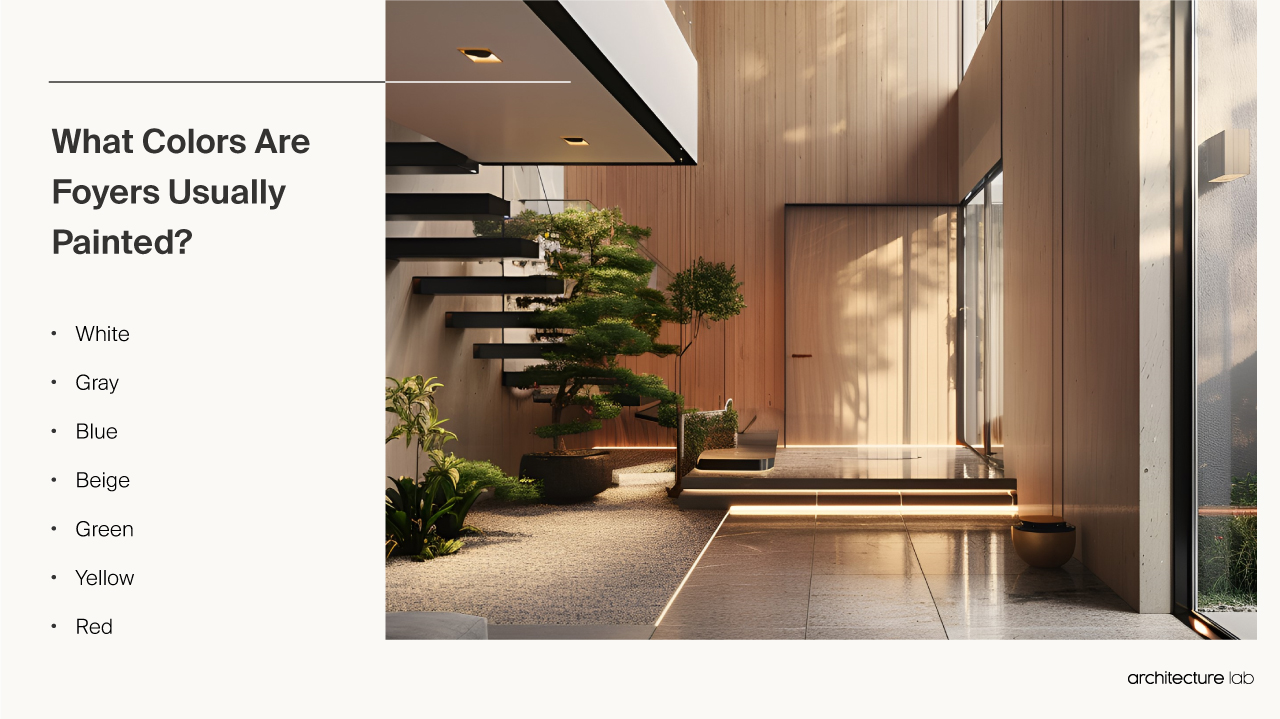
What makes the foyer functional?
The Foyer is functional with sufficient storage, furniture that enables shedding belongings, design accents, and practical furnishings suited to arrival activities. Firstly, the functionality of a foyer is determined by its design and the elements incorporated within it. A well-designed foyer is uncluttered, airy, and spacious, providing a place to put keys, cell phones, or sort mail. It often includes wall hooks for hanging coats, a bench for removing shoes, and a console table for placing keys and purses. Secondly, the foyer is functional because it helps define the space within a home. In an open living room that shares the same floor as the front door, a foyer can be created by specifying the space with a rug or runner. Lastly, a foyer is functional because it aids in the transition from the outside world to the house. It should emanate a warm, welcoming feeling but, at the same time, be as functional as possible.
How is energy efficiency achieved in a foyer?
Energy efficiency is achieved by energy-efficient lighting, maximizing natural light, proper insulation, and using energy-efficient appliances and fixtures. Firstly, energy efficiency in a foyer can be achieved through appropriate lighting. The choice of lighting fixtures and bulbs plays a significant role in energy consumption and greenhouse gases. Energy-efficient bulbs such as LEDs or compact fluorescent lamps (CFLs) can be used instead of traditional incandescent bulbs. Secondly, natural light can be maximized in the foyer to minimize the need for artificial lighting during the day. This can be achieved by placing windows, skylights, or glass doors. Using light-colored or reflective surfaces can also help the natural light more effectively throughout the space. Thirdly, insulation plays a crucial role in energy efficiency. Since the foyer is the first point of contact with the outside, it can significantly influence the home’s temperature. Proper insulation can prevent heat loss in the winter and keep the house cool in the summer, reducing the need for heating and cooling systems. Lastly, using energy-efficient appliances and fixtures can also contribute to energy efficiency. An energy-efficient door can prevent drafts, and a programmable thermostat can help manage the temperature more effectively.
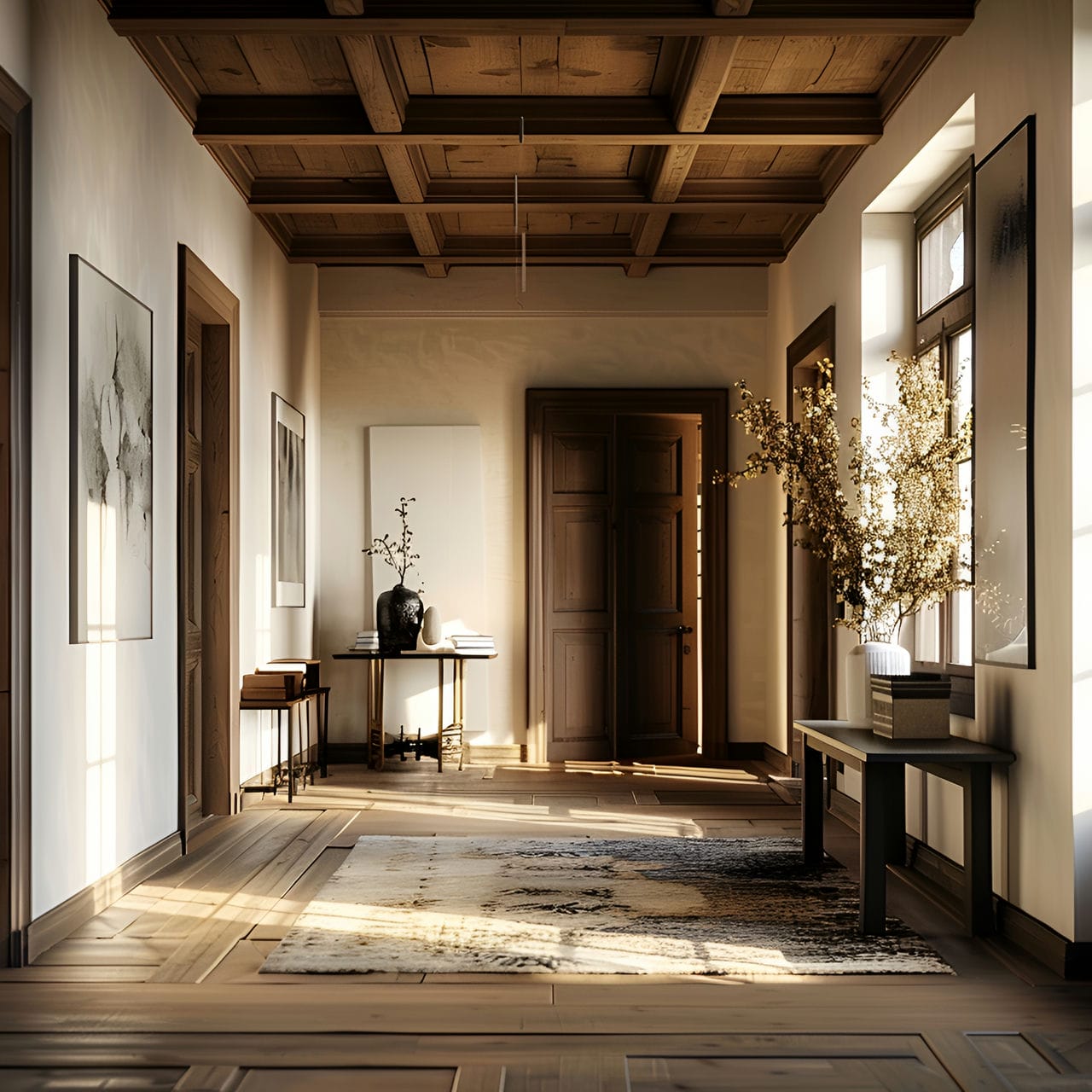
How much does it typically cost to renovate a foyer?
The average cost to renovate an existing foyer space falls between $1,500 (€1,380, £1,180) and $3,000 (€2,760, £2,370). Cosmetic updates like new flooring, paint, or lighting fixtures run closer to $1,500 (€1,380, £1,180) and $2,000 (€1,840, £1,580). Structural changes like adjusting door placements, removing or adding walls, or expanding the footprint drive costs upward to $2,500 (€2,300, £1,970) and $3,000 (€2,760, £2,370. Standard console tables or slim shelves to hold decor run $200 (€184, £158) and $800 (€735, £630). Custom millwork like built-in storage or unique moldings further increases budgets. Top-tier renovations with high-end finishes, statement lighting, specialty floors, and expanded dimensions can reach $5,000 (€4,600, £3,950) and $10,000+ (€9,200+, £7,900+). Standard foyer spaces measuring 5 feet (1.5 meters) x 6.5 feet (2 meters) up to 6.5 feet (2 meters) x 10 feet (3 meters) fall into the typical $1,500 (€1,380, £1,180) to $3,000 (€2,760, £2,370 budget range. For ceiling heights over 10 feet (3 meters) and expanses exceeding 13 feet (4 meters) on each side incorporating lavish furniture, expect proportional budget increases reaching the $10,000+ (€9,200+, £7,900+) tier for luxury estate-level renovations.
What factors affect the foyer renovation?
Listed below are the factors that affect the foyer renovation:
- Wall Condition: The condition of the walls in a foyer can affect the renovation process. Walls in an entryway can take on substantial abuse over time, including scuff marks, dents, dings, and holes.
- Lighting: Lighting is a significant factor in a foyer renovation. The proper lighting can enhance the space’s aesthetic appeal, distract from less appealing elements, and set the mood for the rest of the home.
- Space Availability: The size of the foyer is a critical factor in renovation. The available square footage can dictate the scale of the renovation, the choice of furniture, and the layout.
- Desired Aesthetic: The desired aesthetic or motif for the foyer is a significant factor in the renovation. This includes the choice of color scheme, materials, and design elements. The entrance should complement the exterior and interior of the home, serving as a design transition for the rest of the house.
- Functionality: The functionality of the foyer is a critical consideration in renovation. The foyer serves as a transition space and should be designed to accommodate the household’s needs. This could include storage for shoes and coats, a seating area, or a display for artwork or personal items.
- Budget: The budget for the renovation can affect the foyer scope and quality of the renovation. It can dictate the choice of materials, the extent of structural changes, and the quality of fixtures and fittings.
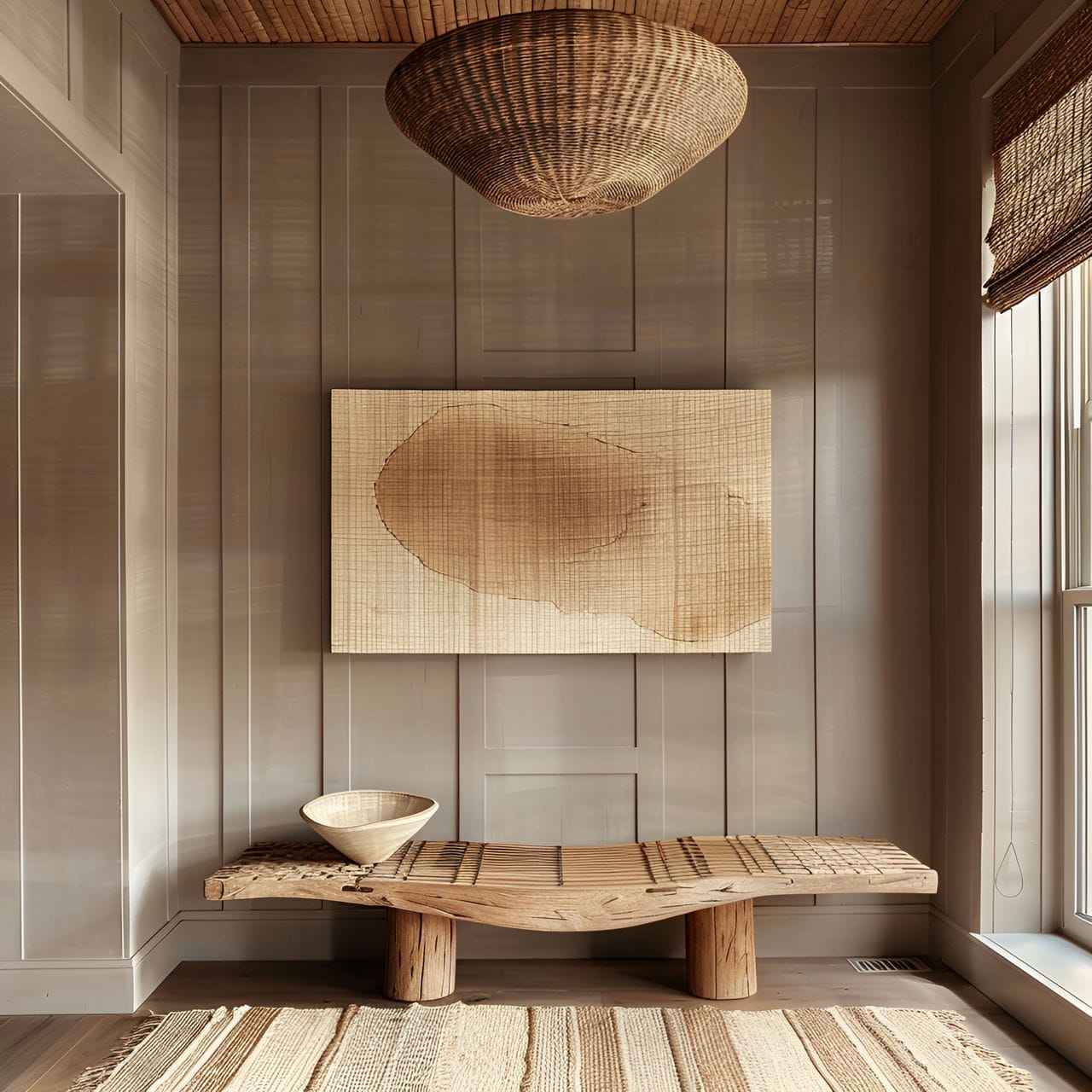
Is an architect required to renovate a foyer?
No, an architect is not always required to renovate a foyer, but it is recommended, as their expertise can be valuable for significant changes. An architect is unnecessary for simple renovations like painting or minor decor updates. Consulting an architect is advisable if the renovation involves structural changes, reconfiguring the space, or altering load-bearing walls. They ensure the design is pleasing and structurally sound, complying with building codes and regulations. For homeowners seeking a transformative renovation with complex design elements, an architect’s design, planning, and project management skills can be instrumental in achieving the desired outcome.
How can an architect help you upgrade a foyer?
Listed below are ways an architect can help an owner upgrade a foyer:
- Space Optimization: An architect can help maximize foyer space. Foyers are smaller rooms, and an architect can suggest upgrades like custom paneling, wallpaper, or plaster to enhance the space.
- Structural Changes: Architects can guide through potential structural changes in the foyer. This could include altering the layout, removing or adding walls, or changing the height of the ceiling.
- Lighting Design: Lighting is essential in a foyer. An architect can help design a lighting plan that enhances the space’s aesthetic appeal, distracts from less appealing elements, and sets the mood for the rest of the home.
- Material Selection: An architect can assist in selecting durable, attractive, and suitable materials for the foyer. This could include flooring materials, wall coverings, and finishes.
- Aesthetic Guidance: Architects can guide the foyer’s overall aesthetic. They can help choose a color scheme, design style, and decorative elements that complement the rest of the home.
- Budget Management: An architect can help manage the budget for foyer renovation. They can provide cost estimates for different design options, suggest areas where to save money, and help ensure it gets the most value for investment.
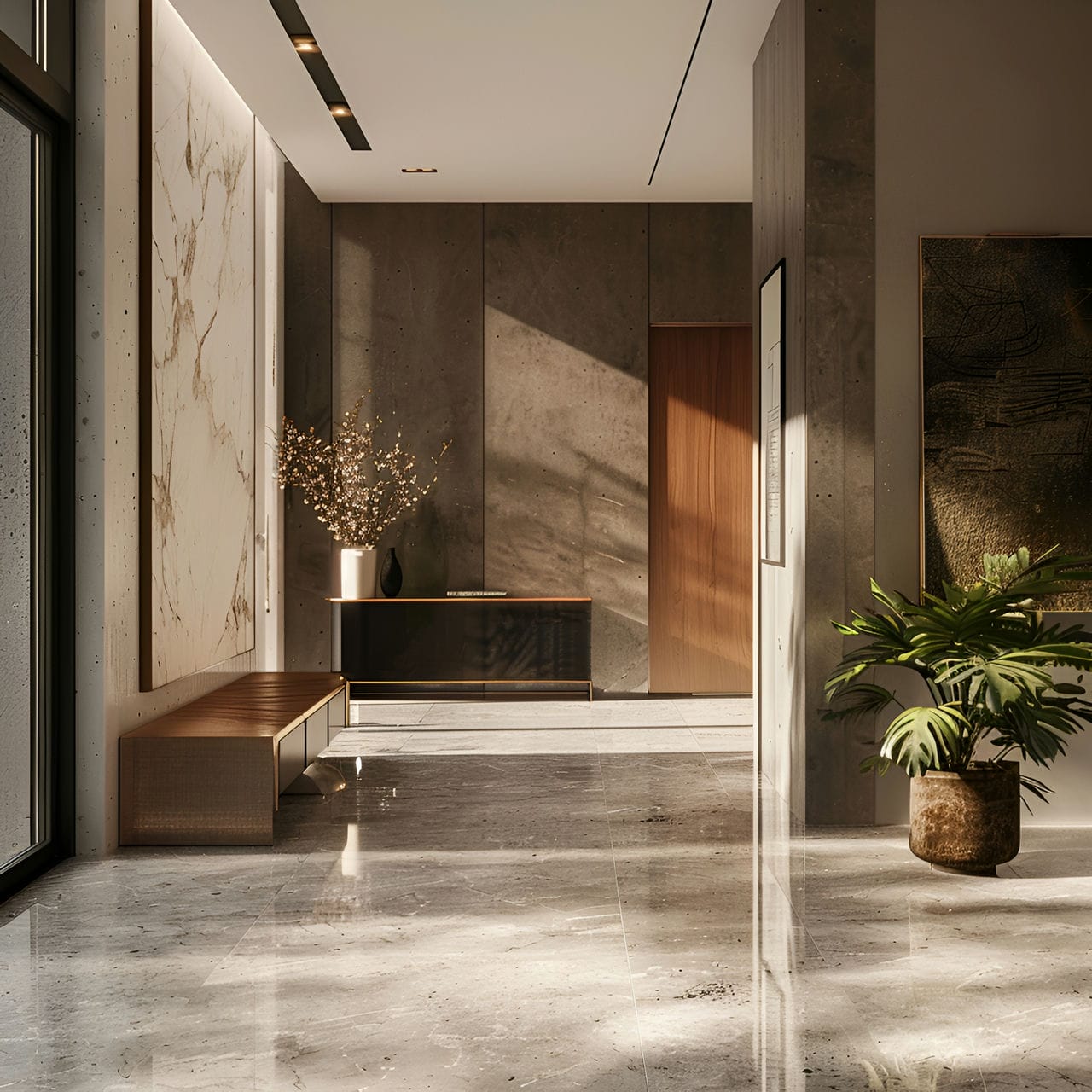
How much does it cost to hire an architect to renovate a foyer?
The average cost to hire an architect to design a foyer renovation ranges from $1,000 (€920, £790) to $5,000 (€4,600, £3,950) on the high end based on the scale and details involved. Most residential architects charge $80-$150 (€73-€138, £63-£118) per hour. A minor foyer update with simple cosmetic changes like lighting, flooring, or paint in a typical 5 x 6.5 foot (1.5 x 2 meter) space takes 8-12 hours for a modest $1,200 (€1,080, £915) design fee. Moderate renovations spanning a 6.5 x 10 foot (2 x 3 meter) foyer incorporating structural changes like opening walls and adjusting entryways or built-ins require closer to 15-25 hours of design time, $2,000 (€1,840, £1,580). Top-tier interior designers creating truly custom, high-end contemporary foyers or grand estate entrances with specialty stone floors, statement staircases, intricate millwork, and expanded 13 x 20+ foot (4 x 6+ meter) dimensions charge $5,000+ (€4,600+, £3,950+) and may spend 30 hours or more perfecting bespoke plans. Simple foyer touch-ups cost $1,000 to $2,000 (€920 to €1,840, £790 to £1,580) for the architect’s services, while extensive structural reconfigurations or luxe facilities match their complexity from $3,000 to $5,000+ (€2,760 to €4,600+, £2,370 to £3,950+).
Is it worth it to hire an architect to upgrade a foyer?
Yes, hiring an architect to upgrade a foyer can be worth it, depending on the scope and complexity of the project. If the upgrade involves structural changes, significant alterations in layout, or custom design elements, an architect’s expertise ensures that these modifications are pleasing, technically sound, and compliant with building codes. Architects bring creative solutions to optimize space, improve functionality, and enhance the visual appeal of the foyer. An architect might be optional for simple cosmetic updates, like painting or fundamental decor changes.
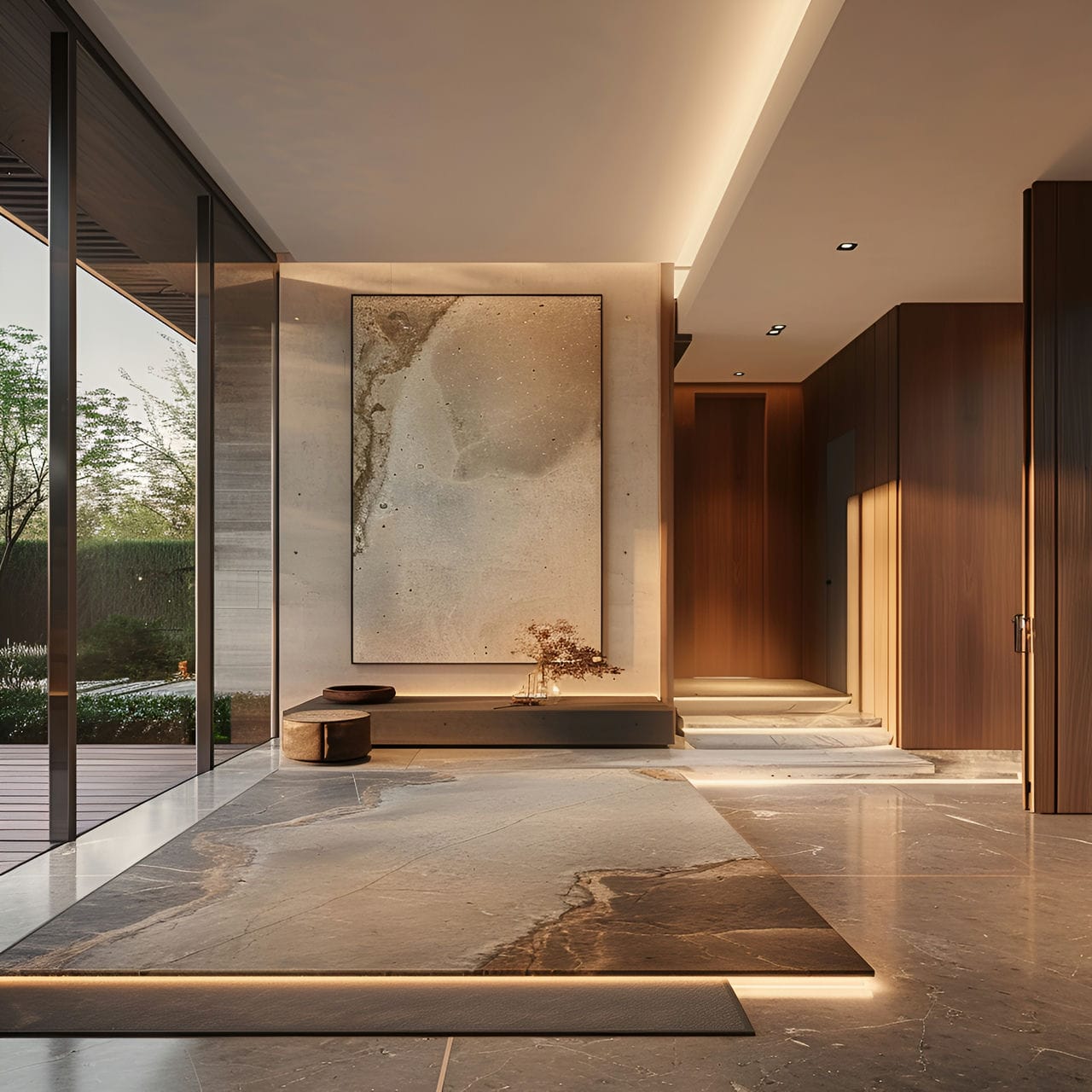
How long is needed to redecorate a foyer?
2 to 6 weeks is needed to redecorate the foyer. Firstly, the scope of redecoration is a primary determinant. Minor updates like repainting or adding new decor are quicker and usually completed within two weeks. Secondly, more extensive renovations, such as flooring replacement or structural modifications, extend the timeline, often requiring 4 to 6 weeks. Thirdly, the availability and delivery of materials and furniture can impact the schedule. Delays in obtaining specific items can prolong the project. Fourthly, the complexity of the design influences the duration. Lastly, the efficiency of the workforce and the homeowner’s decision-making speed are crucial. Prompt decisions and a skilled workforce can expedite the process, while indecision and scheduling conflicts can cause delays.
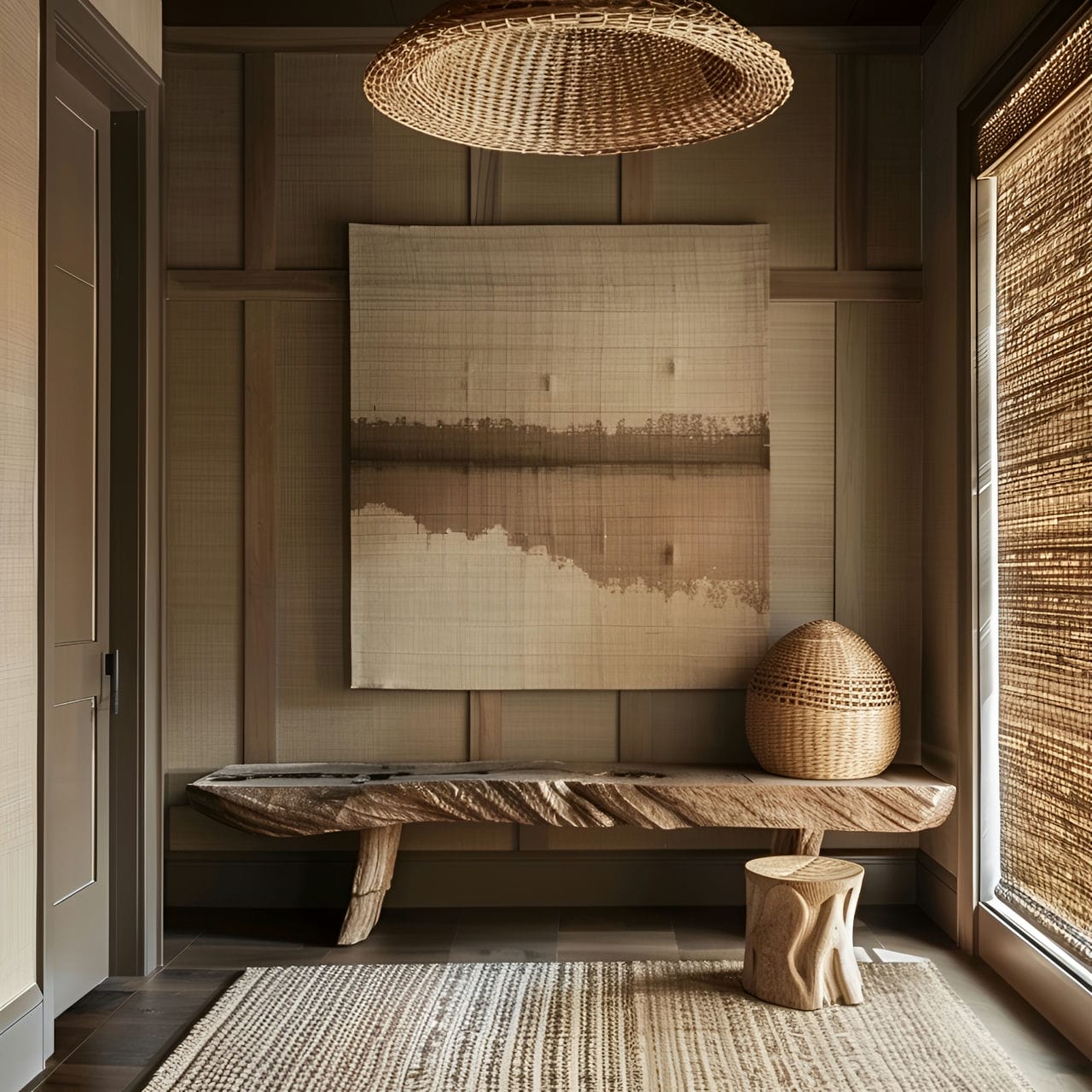
What are the struggles of the homeowner to redecorate a foyer?
Listed below are the struggles of the homeowner to redecorate a foyer:
- Clutter Management: One of the homeowners’ biggest struggles when redecorating a foyer is managing clutter. Foyers often become a dumping ground for mail, coats, and backpacks. Finding stylish and functional storage solutions that fit the space and decor can be challenging.
- Limited Space: Foyers are smaller rooms, making redecorating challenging. There may be limited wall space for artwork or mirrors, and finding furniture that fits the space without making it feel cramped or cluttered can be difficult.
- Wall Condition: The walls in a foyer can take substantial abuse over time, including scuff marks, dents, dings, and holes. These damages can occur from various sources, and addressing them can be a significant part of redecorating a foyer.
- Lighting: Lighting is essential in a foyer but can also be challenging. The proper lighting can enhance the space’s aesthetic appeal, distract from less appealing elements, and set the mood for the rest of the home.
- Style Selection: Choosing a style for the foyer that complements the rest of the home can be difficult. The entrance needs to make a style statement, but it also needs to transition smoothly to the other rooms in the house.
- Budget: Budget is often a struggle when redecorating a foyer. Homeowners must balance their desire for high-quality materials and fixtures with their available budget.


